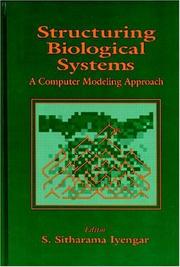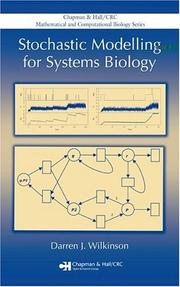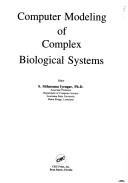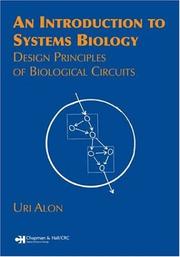| Listing 1 - 10 of 11 | << page >> |
Sort by
|

ISBN: 084937961X Year: 1992 Publisher: Boca Raton, Fla. Ann Arbor London CRC Press
Abstract | Keywords | Export | Availability | Bookmark
 Loading...
Loading...Choose an application
- Reference Manager
- EndNote
- RefWorks (Direct export to RefWorks)

ISBN: 9781584885405 1584885408 Year: 2006 Publisher: Boca Raton: Chapman & Hall/CRC,
Abstract | Keywords | Export | Availability | Bookmark
 Loading...
Loading...Choose an application
- Reference Manager
- EndNote
- RefWorks (Direct export to RefWorks)
Book
ISBN: 0442004796 Year: 1991 Publisher: New York Van Nostrand Reinhold
Abstract | Keywords | Export | Availability | Bookmark
 Loading...
Loading...Choose an application
- Reference Manager
- EndNote
- RefWorks (Direct export to RefWorks)

ISBN: 0849352088 9780849352089 Year: 1984 Publisher: Boca Raton (Fla.): CRC,
Abstract | Keywords | Export | Availability | Bookmark
 Loading...
Loading...Choose an application
- Reference Manager
- EndNote
- RefWorks (Direct export to RefWorks)
MODELS, BIOLOGICAL --- COMPUTERS --- Biological systems --- MODELS, THEORETICAL --- Mathematical models --- Data processing --- Biosystems --- Systems, Biological --- Biology --- System theory --- Systems biology --- Philosophy --- Biological systems - Mathematical models --- Biological systems - Data processing
Book
ISBN: 1849964734 9786612973222 1282973223 1849964742 Year: 2011 Publisher: New York : Springer,
Abstract | Keywords | Export | Availability | Bookmark
 Loading...
Loading...Choose an application
- Reference Manager
- EndNote
- RefWorks (Direct export to RefWorks)
The emerging, multi-disciplinary field of systems biology is devoted to the study of the relationships between various parts of a biological system, and computer modeling plays a vital role in the drive to understand the processes of life from an holistic viewpoint. Advancements in experimental technologies in biology and medicine have generated an enormous amount of biological data on the dependencies and interactions of many different molecular cell processes, fueling the development of numerous computational methods for exploring this data. The mathematical formalism of Petri net theory is able to encompass many of these techniques. This essential text/reference presents a comprehensive overview of cutting-edge research in applications of Petri nets in systems biology, with contributions from an international selection of experts. Those unfamiliar with the field are also provided with a general introduction to systems biology, the foundations of biochemistry, and the basics of Petri net theory. Further chapters address Petri net modeling techniques for building and analyzing biological models, as well as network prediction approaches, before reviewing the applications to networks of different biological classification. Topics and features: Investigates the modular, qualitative modeling of regulatory networks using Petri nets, and examines an Hybrid Functional Petri net simulation case study Contains a glossary of the concepts and notation used in the book, in addition to exercises at the end of each chapter Covers the topological analysis of metabolic and regulatory networks, the analysis of models of signaling networks, and the prediction of network structure Provides a biological case study on the conversion of logical networks into Petri nets Discusses discrete modeling, stochastic modeling, fuzzy modeling, dynamic pathway modeling, genetic regulatory network modeling, and quantitative analysis techniques Includes a Foreword by Professor Jens Reich, Professor of Bioinformatics at Humboldt University and Max Delbrück Center for Molecular Medicine in Berlin This unique guide to the modeling of biochemical systems using Petri net concepts will be of real utility to researchers and students of computational biology, systems biology, bioinformatics, computer science, and biochemistry. Dr. Ina Koch is a Professor and holds the Chair of Bioinformatics at the Johann Wolfgang Goethe-University Frankfurt am Main, Germany. Dr. Wolfgang Reisig is a Professor and holds the Chair in the Theory of Programming at the Humboldt University of Berlin, Germany. Dr. Falk Schreiber is a Professor and holds the Chair of Bioinformatics at the Martin Luther University Halle-Wittenberg, Germany, and the Coordinator of Bioinformatics at the Leibniz Institute of Plant Genetics and Crop Plant Research Gatersleben, Germany.
Bioinformatics. --- Biological systems -- Computer simulation. --- Biological systems -- Mathematical models. --- Computational biology. --- Systems biology. --- Systems biology --- Petri nets --- Biology --- Health & Biological Sciences --- Biology - General --- Petri nets. --- Computer science. --- Computer Science. --- Computational Biology/Bioinformatics. --- Systems Biology. --- Computational biology --- Bioinformatics --- Biological systems --- Molecular biology --- Bio-informatics --- Biological informatics --- Information science --- Informatics --- Science --- Data processing --- Graph theory --- Nets (Mathematics) --- Biological models. --- Models, Biological
Book
ISSN: 2191544X ISBN: 8132207629 8132207637 1283908328 Year: 2012 Publisher: New Delhi : Springer,
Abstract | Keywords | Export | Availability | Bookmark
 Loading...
Loading...Choose an application
- Reference Manager
- EndNote
- RefWorks (Direct export to RefWorks)
This work is an overview of statistical inference in stationary, discrete time stochastic processes. Results in the last fifteen years, particularly on non-Gaussian sequences and semi-parametric and non-parametric analysis have been reviewed. The first chapter gives a background of results on martingales and strong mixing sequences, which enable us to generate various classes of CAN estimators in the case of dependent observations. Topics discussed include inference in Markov chains and extension of Markov chains such as Raftery's Mixture Transition Density model and Hidden Markov chains and extensions of ARMA models with a Binomial, Poisson, Geometric, Exponential, Gamma, Weibull, Lognormal, Inverse Gaussian and Cauchy as stationary distributions. It further discusses applications of semi-parametric methods of estimation such as conditional least squares and estimating functions in stochastic models. Construction of confidence intervals based on estimating functions is discussed in some detail. Kernel based estimation of joint density and conditional expectation are also discussed. Bootstrap and other resampling procedures for dependent sequences such as Markov chains, Markov sequences, linear auto-regressive moving average sequences, block based bootstrap for stationary sequences and other block based procedures are also discussed in some detail. This work can be useful for researchers interested in knowing developments in inference in discrete time stochastic processes. It can be used as a material for advanced level research students.
Biological systems -- Mathematical models. --- Computational biology. --- Models, Biological. --- Systems biology. --- Stochastic processes --- Time-series analysis --- Mathematics --- Physical Sciences & Mathematics --- Mathematical Statistics --- Mathematical models --- Stochastic processes. --- Mathematical statistics. --- Statistics. --- Statistical Theory and Methods. --- Statistics, general. --- Random processes --- Probabilities --- Statistical inference --- Statistics, Mathematical --- Statistics --- Sampling (Statistics) --- Statistical methods --- Statistical analysis --- Statistical data --- Statistical science --- Econometrics --- Statistics .
Book
ISBN: 1489984984 1441903585 9786612292316 1282292315 1441903593 9781441903587 Year: 2010 Publisher: New York: Springer,
Abstract | Keywords | Export | Availability | Bookmark
 Loading...
Loading...Choose an application
- Reference Manager
- EndNote
- RefWorks (Direct export to RefWorks)
Mathematical modeling in the biological sciences is growing exponentially because the general area provides exciting problems from biology to medicine, and this goes under the name mathematical biology. Moreover, models of the growth of microorganisms have become very popular since mathematical predictions can be tested in the laboratory employing a device known as the chemostat. Such models are called chemostat models. This book attempts to present a self contained account of mathematical model building theory of microbial populations. Key Features: Covers all fundamental concepts and mathematical skills needed to build models for microbial populations. Provides an accessible and informative over view of known literature including several practical techniques. Presents a comprehensive analysis of chemostat models and their limitations in adapting to natural lakes. A thorough discussion on the design of biologically viable control mechanisms (termed bio-control mechanisms) to contain the instability tendencies. Construction of a variety of Lyapunov functionals for global stability analysis. This book is ideal for a general scientific and engineering audience requiring an in-depth exposure to current ideas, methods and models. The topics discussed can serve as a one to two semester course material for senior under graduate and graduate students. It is a useful reference for practitioners, researchers, and professionals in applied mathematics, biology, agriculture, limnology, chemical and civil engineering.
Biological systems -- Mathematical models. --- Chemostat. --- Microbial populations -- Mathematical models. --- Microbiological Processes. --- Models, Biological. --- Biological systems --- Microbial populations --- Chemostat --- Epidemiologic Measurements --- Models, Theoretical --- Investigative Techniques --- Microbiological Phenomena --- Statistics as Topic --- Phenomena and Processes --- Analytical, Diagnostic and Therapeutic Techniques and Equipment --- Public Health --- Epidemiologic Methods --- Environment and Public Health --- Health Care --- Biometry --- Microbiological Processes --- Models, Biological --- Methods --- Biology --- Health & Biological Sciences --- Biology - General --- Mathematical models --- Biomathematics. --- Computational biology. --- Mathematics --- Life sciences. --- Systems biology. --- Microbial ecology. --- Community ecology, Biotic. --- Ecology. --- Life Sciences. --- Systems Biology. --- Mathematical and Computational Biology. --- Theoretical Ecology/Statistics. --- Community & Population Ecology. --- Microbial Ecology. --- Bioinformatics --- Biological models. --- Balance of nature --- Bionomics --- Ecological processes --- Ecological science --- Ecological sciences --- Environment --- Environmental biology --- Oecology --- Environmental sciences --- Population biology --- Environmental microbiology --- Microorganisms --- Ecology --- Microbiology --- Ecology . --- Biocenoses --- Biocoenoses --- Biogeoecology --- Biological communities --- Biomes --- Biotic community ecology --- Communities, Biotic --- Community ecology, Biotic --- Ecological communities --- Ecosystems --- Natural communities --- Computational biology --- Molecular biology --- Biological systems - Mathematical models --- Microbial populations - Mathematical models

ISBN: 1584886420 9781584886426 Year: 2007 Volume: 10 Publisher: Boca Raton (Fla.): Chapman & Hall/CRC,
Abstract | Keywords | Export | Availability | Bookmark
 Loading...
Loading...Choose an application
- Reference Manager
- EndNote
- RefWorks (Direct export to RefWorks)
An Introduction to Systems Biology: Design Principles of Biological Circuits builds a solid foundation for the intuitive understanding of general principles. It encourages the reader to ask why a system is designed in a particular way and then proceeds to answer with simplified models. Explains the basic circuitry in transcription regulation, signal transduction, and developmental networks Includes examples ranging from bacterial chemotaxis through developmental patterning and neuronal circuits to immune recognition Examines the principle of robustness Details how constrained evolutionary optimization can be used to understand optimal circuit design Considers how kinetic proofreading and other mechanisms can minimize errors made in biological information-processing Includes solved problems after each chapter that detail topics not discussed in the main text Thorough and accessible, this book presents the design principles of biological systems, and highlights the recurring circuit elements that make up biological networks. It provides a simple mathematical framework which can be used to understand and even design biological circuits. The text avoids specialist terms, focusing instead on several well-studied biological systems that concisely demonstrate key principles.
Biomathematics. Biometry. Biostatistics --- Mathematical statistics --- Computational biology --- Biological systems --- Bio-informatique --- Systèmes biologiques --- Mathematical models --- Modèles mathématiques --- Systems biology --- Cellule --- cells --- Biologie --- biology --- Développement biologique --- biological development --- Réseau de neurones --- Neural networks --- Mécanisme chimiotactique --- Chemotaxis --- Facteur de transcription --- Transcription factors --- Immunogénétique --- Immunogenetics --- Expression des gènes --- gene expression --- Biosystems --- Systems, Biological --- Biology --- System theory --- Philosophy --- Computational biology. --- Systems biology. --- Basic Sciences. Biology --- Mathematical models. --- Biosystematics --- Biosystematics. --- Systèmes biologiques --- Modèles mathématiques --- Bioinformatics --- Molecular biology --- Biological systems - Mathematical models

ISBN: 0195080130 9780195080131 Year: 1994 Volume: 2 Publisher: New York: Oxford university press,
Abstract | Keywords | Export | Availability | Bookmark
 Loading...
Loading...Choose an application
- Reference Manager
- EndNote
- RefWorks (Direct export to RefWorks)
Chaotic behavior in systems --- Fractals --- Physiology --- Biological systems --- Mathematical models --- -Chaotic behavior in systems --- -Animal physiology --- Animals --- Biology --- Anatomy --- Fractal geometry --- Fractal sets --- Geometry, Fractal --- Sets, Fractal --- Sets of fractional dimension --- Dimension theory (Topology) --- Chaos in systems --- Chaos theory --- Chaotic motion in systems --- Differentiable dynamical systems --- Dynamics --- Nonlinear theories --- System theory --- Biosystems --- Systems, Biological --- Systems biology --- Philosophy --- -Mathematical models --- -Fractal geometry --- Animal physiology --- Physiology - Mathematical models --- Biological systems - Mathematical models
Book
ISBN: 9810201273 9810201281 Year: 1990 Volume: 1 Publisher: Singapore New Jersey World Scientific
Abstract | Keywords | Export | Availability | Bookmark
 Loading...
Loading...Choose an application
- Reference Manager
- EndNote
- RefWorks (Direct export to RefWorks)
Chaotic behavior in systems. --- Fractals. --- Medicine --- Physiology --- Mathematical models. --- Systems Theory --- Human physiology --- Mathematics. --- Medicine. --- Models, Biological. --- Statistics --- Systems Theory. --- Biological systems --- Chaotic behavior in systems --- Fractals --- Systèmes biologiques --- Chaos --- Fractales --- Physiologie --- Mathematical models --- Modèles mathématiques --- Biological systems - Mathematical models. --- Physiology - Mathematical models. --- Health Workforce --- Fractal geometry --- Fractal sets --- Geometry, Fractal --- Sets, Fractal --- Sets of fractional dimension --- Dimension theory (Topology) --- Chaos in systems --- Chaos theory --- Chaotic motion in systems --- Differentiable dynamical systems --- Dynamics --- Nonlinear theories --- System theory
| Listing 1 - 10 of 11 | << page >> |
Sort by
|

 Search
Search Feedback
Feedback About UniCat
About UniCat  Help
Help News
News